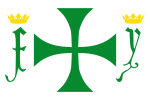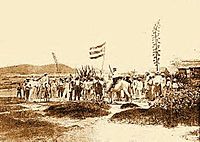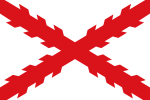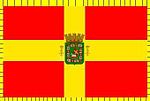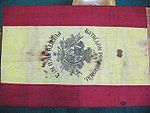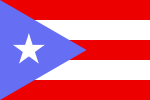- Flags of Puerto Rico
-
Flag of Puerto Rico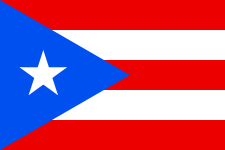
Name Current flag of Puerto Rico 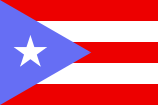
Variant flag of Puerto Rico Name (1892 Flag version with light blue tone) 
Variant flag of Puerto Rico Name (1952-1995 flag version with dark blue tone) Use Civil and state flag and ensign 
Proportion 2:3 Design Five equal horizontal bands of red (top and bottom) alternating with white; a blue (tone of blue may vary) isosceles triangle based on the hoist side bears a large, white, five-pointed star in the center. 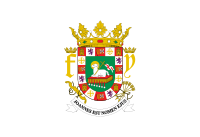 The Flag of the Governor of Puerto Rico, which is flown over La Fortaleza, the Governor's Mansion, when the elected Governor of Puerto Rico is in Puerto Rico
The Flag of the Governor of Puerto Rico, which is flown over La Fortaleza, the Governor's Mansion, when the elected Governor of Puerto Rico is in Puerto Rico
The flags of Puerto Rico represent and symbolize the island and people of Puerto Rico. The most commonly used flags of Puerto Rico are the current flag, which represents the people of the commonwealth of Puerto Rico; municipal flags, which represent the different regions of the island; political flags, which represent the political beliefs of the people; and sports flags, which identify Puerto Rico as the country represented by its athletics during competitions.
The origins of the current flag of Puerto Rico, adopted by the commonwealth of Puerto Rico in 1952, can be traced to 1868, when the first Puerto Rican flag, "The Revolutionary Flag of Lares", was conceived by Dr. Ramón Emeterio Betances and embroidered by Mariana "Brazos de Oro" Bracetti. This flag was used in the short-lived Puerto Rican revolt against Spanish rule in the island, known as "El Grito de Lares".[1][2]
Juan de Mata Terreforte, an exiled veteran of "El Grito de Lares" and Vice-President of Puerto Rican Revolutionary Committee, in New York City, adopted the flag of Lares as the flag of Puerto Rico until 1892, when the current design, modeled after the Cuban flag, was unveiled and adopted by the committee.[3] The new flag, which consisted of five equal horizontal bands of red (top and bottom) alternating with white; a blue isosceles triangle based on the hoist side bears a large, white, five-pointed star in the center, was first flown in Puerto Rico on March 24, 1897, during the "Intentona de Yauco" revolt. The use and display of the Puerto Rican flag was outlawed and the only flags permitted to be flown in Puerto Rico were the Spanish flag (1492 to 1898) and the flag of the United States (1898 to 1952).
In 1952, the Commonwealth of Puerto Rico adopted the same flag design, which was unveiled in 1892 by the Puerto Rican Revolutionary Committee, as its official standard without specifying the tones of colors to be used. The color of the triangle that was used by the administration of Luis Muñoz Marín was the dark blue that is used in the flag of the United States, instead of the original light blue, thus creating a political controversy which has lasted throughout the years.[4] In 1995, the government of Puerto Rico, issued a regulation in regard to the use of the Puerto Rican flag titled: "Reglamento sobre el Uso en Puerto Rico de la Bandera del Estado Libre Asociado de Puerto Rico" in which the government specifies the colors to be used but, does not specify any official color tones or shades. Therefore, it is not uncommon to see the flag of Puerto Rico with different shades of blue displayed in the island.[5] Several Puerto Rican flags were aboard the Space Shuttle Discovery during its flight into outer space on March 15, 2009.[6]
Each of the 78 municipalities of Puerto Rico has adopted flags which represent the region and its people. Most of the designs of these flags derive their symbolism from the regions Coat of Arms. Most of the political parties in Puerto Rico also have their own flags, which represent and symbolize the political ideals of its members. These flags are usually displayed in public during rallies, meetings, or parades in show of political strength and unity. Various sports associations in Puerto Rico have adopted flags which represent them and which are also used during competitions and sports events.
Contents
First flags used in Puerto Rico
The introduction of a flag in Puerto Rico can be traced to when Christopher Columbus landed on the island's shore and with the flag appointed to him by the Spanish Crown claimed the island, which he named "San Juan Bautista", in the name of Spain. Columbus wrote in his logbook that on October 12, 1492, he used the Royal Flag, and that his captains used two flags which the Admiral carried in all the ships as Ensign, each white with a green cross in the middle and an 'F' and 'Y', both green and crowned with golden, open royal crowns, for Ferdinand II of Aragon and Ysabel (Isabel I).[7] The conquistadores under the command of Juan Ponce de León proceeded to conquer and settle the island. They carried as their military standard the "Spanish Expedition Flag". After the island was conquered and colonized, the flag of Spain was used in Puerto Rico, same as it was used in all of its other colonies.[8]
Once the Spanish armed forces established themselves on the island they began the construction of military fortifications such as La Fortaleza, Fort San Felipe del Morro, Fort San Cristóbal and San Gerónimo. The Spanish Army designed the "Burgundy Cross Flag" and adopted it as their standard. This flag flew wherever there was a Spanish military installation.[9]
The first flag of Puerto Rico
The independence movement in Puerto Rico gained momentum with the liberation successes of Simón Bolívar and José de San Martín in South America. In 1868, local independence leader Ramón Emeterio Betances urged Mariana Bracetti to knit a revolutionary flag using the flag of the Dominican Republic as an example. The flag was divided in the middle by a white Latin cross, the two lower corners were red and the two upper corners were blue with a white star in the upper left blue corner. According to Puerto Rican poet Luis Llorens Torres the white cross on it stands for the yearning for homeland redemption; the red squares, the blood poured by the heroes of the rebellion and the white star in the blue solitude square, stands for liberty and freedom.[10] The "Revolutionary Flag of Lares" was used in the short-lived rebellion against Spain in what became known as El Grito de Lares (The Cry of Lares).[11] The flag was proclaimed the national flag of the "Republic of Puerto Rico" by Francisco Ramírez Medina, who was sworn in as Puerto Rico's first president, and placed on the high alter of the Catholic Church of Lares, thus becoming the first Puerto Rican Flag.[1] The original Lares flag was taken by a Spanish army officer as a war prize. Many years later it was returned and transferred to the Puerto Rican people. It is now exhibited in the University of Puerto Rico's Museum.[1]
In 1873, following the abdication of Amadeus, Duke of Aosta, as King (1870–1873) and with Spain's change from Kingdom to Republic, the Spanish government issued a new colonial flag for Puerto Rico. The new flag, which was used until 1873, resembled the flag of Spain, with the difference that it had the coat of arms of Puerto Rico in the middle. Spain's flag once more flew over Puerto Rico with the restoration of the Spanish kingdom in 1873, until 1898 the year that the island became a possession of the United States under the terms of the Treaty of Paris (1898) in the aftermath of the Spanish-American War.[12]
History of the current flag of Puerto Rico
Origins
 Puerto Rican Revolutionary Committee
Puerto Rican Revolutionary Committee
(standing L-R) Manuel Besosa, Aurelio Méndez Martínez, and Sotero Figueroa (seated L-R) Juan de M. Terreforte, D. Jose Julio Henna and Roberto H. ToddJuan de Mata Terreforte, a leader of the Grito de Lares revolt who fought alongside Manuel Rojas, was exiled to New York City. He joined the Puerto Rican Revolutionary Committee and was named its Vice-President.[3] Terreforte and the members of the Revolutionary committee adopted the Flag of Lares as their standard. In 1892, the Committee was presented with the design of the current flag of Puerto Rico. The new flag's design has been attributed to various Puerto Ricans who were members of the Puerto Rican Revolutionary Committee in New York City.
Some sources document Francisco Gonzalo Marín with presenting a Puerto Rican flag prototype in 1895 for adoption by the Puerto Rican Revolutionary Committee in New York City. Marín has since been credited by some with the flag's design.[13] There is a letter written by Juan de Mata Terreforte which gives credit to Marin. The original contents of the letter in Spanish are the following:[14]
"La adopción de la bandera cubana con los colores invertidos me fue sugerida por el insigne patriota Francisco Gonzalo Marín en una carta que me escribió desde Jamaica. Yo hice la proposición a los patriotas puertorriqueños que asistieron al mitin de Chimney Hall y fue aprobada unánimemente."
Which translated in English states the following: The adaptation of the Cuban flag with the colors inverted was suggested by the patriot Francisco Gonzalo Marín in a letter which he wrote from Jamaica. I made the proposition to various Puerto Rican patriots during a meeting at Chimney Hall and it was approved unanimously.[14]
According to other accounts on June 12, 1892, Antonio Vélez Alvarado was at his apartment at 219 Twenty-Third Street in Manhattan, when he stared at a Cuban flag for a few minutes, and then took a look at the blank wall in which it was being displayed. Vélez suddenly perceived an optical illusion, in which he perceived the image of the Cuban flag with the colors in the flag's triangle and stripes inverted. Almost immediately he visited a nearby merchant, Domingo Peraza, from whom he bought some crepe paper to build a crude prototype. He later displayed his prototype in a dinner meeting at his neighbor's house, where the owner, Micaela Dalmau vda. de Carreras, had invited José Martí as a guest. Martí was pleasantly impressed by the prototype, and made note of it in a newspaper article published in the Cuban revolutionary newspaper Patria, published on July 2 of that year. Acceptance of the prototype was slow in coming, but grew with time. Francisco Gonzalo Marín, who decided to have a proper flag sewn based on the prototype, presented the new flag's design in New York's "Chimney Corner Hall" a gathering place of independence advocates two years later. The Puerto Rican Flag (with the light blue triangle) soon came to symbolize the ideals of the Puerto Rican independence movement.[15]
In a letter written by Maria Manuela (Mima) Besosa, the daughter of the Puerto Rican Revolutionary Committee member Manuel Besosa, she stated that she sewed the flag. This created a belief that her father could have been its designer. In her letter she described the flag as one which consists of five stripes that alternate from red to white. Three of the stripes are red, and the other two are white. To the left of the flag is a light blue triangle that houses one white five-pointed star. Each part of this flag has its own meaning. The three red stripes represent the blood from the brave warriors. The two white stripes represent the victory and peace that they would have after gaining independence. The white star represented the island of Puerto Rico. The blue represents the sky and blue coastal waters. The triangle represents the three branches of government.[16] Finally, it is also believed by some that it was Lola Rodríguez de Tió who suggested that Puerto Ricans use the Cuban flag with its colors reversed as the model for their own standard.[17]
It may never be known who designed the current flag, however what is known is that on December 22, 1895, the Puerto Rican Revolutionary Committee officially adopted the design which represents the current flag. In 1897, Antonio Mattei Lluberas visited the Puerto Rican Revolutionary Committee in New York City to plan an uprising in Yauco. He returned to Puerto Rico with a Puerto Rican flag[18] and on March 24, 1897, a group of men, led by Fidel Vélez, carried the Puerto Rican flag and attacked the barracks of Spanish Civil Guard of the town Yauco during the revolt against Spanish rule which became known as the "Intentona de Yauco" (Attempted Coup of Yauco). The revolt, which was the second and last major attempt against the Spaniards in the island, was the first time that the flag of Puerto Rico was used in Puerto Rican soil.[19][20]
Puerto Rican flag is outlawed
 Puerto Rican flag removed by a soldier after the 1950 Jayuya Uprising.
Puerto Rican flag removed by a soldier after the 1950 Jayuya Uprising.
From 1898 to 1952, after the December 10, 1898 annexation of Puerto Rico by the United States, it was considered a felony to display the Puerto Rican flag in public; the only flag permitted to be flown on the island was the flag of the United States.[21] However, the Puerto Rican flag was often used in the political assemblies of the pro-independence Liberal Party of Puerto Rico and in defiance by the Puerto Rican Nationalist Party. In 1932, the Nationalist Party used the flag as its emblem during the elections and in their parades. The Puerto Rico legislature presided by then President of the Puerto Rican Senate Luis Muñoz Marín, passed a bill, known as Law 53, making it illegal to display the Puerto Rico Flag, sing a Puerto Rican patriotic song and talk of independence for the islands of Puerto Rico. On June 10, 1948, the United States appointed Governor of Puerto Rico, Jesús T. Piñero, signed the bill which became known as the "Ley de la Mordaza" (Gag Law).[22] Later that same year Puerto Ricans were permitted to elect a governor and they elected Luis Muñoz Marín. During the Jayuya Uprising of 1950 against United States rule, members of the Nationalist party placed the Puerto Rican flag on top of the town hall; the flag was later taken down by a soldier.
Adoption of the Puerto Rican flag
In 1952, Governor Luis Muñoz Marín and his administration adopted the Puerto Rican flag which was originally designed in 1892, and proclaimed it the official flag of Puerto Rico. The official adaptation of the flag has been interpreted by some as a ploy by Muñoz Marin to neutralize the independence movement in his own party.[23] There were some differences between the original flag of 1892 and the one of 1952 and the meaning of the colors was officially changed. Now the white bars stood for the republican form of government, rather than representing the victory and peace that Puerto Ricans were supposed to have after gaining independence.[24] The sky-blue of the triangle in the original flag was changed to dark blue, resembling that of the flag of the United States, to keep it distanced from its revolutionary roots. For nationalist leader Pedro Albizu Campos, having the flag represent the government was a desecration,[25] while the independence party accused the government of "corrupting beloved symbols".[23] In 1995, the government of Puerto Rico began to use the sky-blue version once more.[26][27] The government of Puerto Rico issued a regulation in regard to the use of the Puerto Rican flag titled: "Reglamento sobre el Uso en Puerto Rico de la Bandera del Estado Libre Asociado de Puerto Rico; Reglamento Núm. 5282." (Regulations in regard to the use in Puerto Rico of the flag of Commonwealth of Puerto Rico; Regulation No. 5282). In the regulation's "Artículo 2: Definiciones" and "Artículo 2: Descripción y simbolismo" (Article 2: Description and Article 2: Description and symbolism) the government specifies the colors to be used but does not specify any official color tones or shades and as such it is not unusual to see the flag with either tone of blue flown in official settings in Puerto Rico.[5]
Symbol of pride, defiance and protest
 External audio
External audio
You may listen to "Que Bonita Bandera" (What a beautiful flag) interpreted by Florencio "Ramito" Morales Ramos here On various occasions the flag has been used as a symbol of defiance and protest. In the 1954 attack of the United States House of Representatives in a protest against United States rule of the island, Nationalist leader Lolita Lebrón shouted "¡Viva Puerto Rico Libre!" ("Long live a Free Puerto Rico!") and unfurled the flag of Puerto Rico.[28] On November 5, 2000, Alberto De Jesus Mercado, better known as Tito Kayak, and five other Vieques activists stepped onto the top deck of the Statue of Liberty in New York City, then placed a Puerto Rican flag on the statue's crown in protest of the United States Navy usage of the island of Vieques as a bombing range.[29]
On March 15, 2009, several Puerto Rican flags were aboard the Space Shuttle Discovery during its flight into outer space. Joseph M. Acaba, the first astronaut of Puerto Rican descent, who is assigned to the crew of STS-119 as a Mission Specialist Educator, carried on his person the flag as a symbol of his Puerto Rican heritage.[6] Acacba presented Governor Luis Fortuño and Secretary of State Kenneth McClintock with two of the flags during his visit in June 2009.[30]
The flag is also the subject of the song "Que Bonita Bandera" (What a beautiful flag) written in 1971 and made popular by Puerto Rican folksinger Florencio "Ramito" Morales Ramos. Astronaut Acaba, requested that the crew be awakened on March 19, 2009 (Day 5), with the Puerto Rico folklore song, sung by Jose Gonzalez and Banda Criolla, during their space flight.[31]
Municipal flags of Puerto Rico
Each of the municipalities of Puerto Rico, including the islands of Culebra and Vieques, have adopted a flag which represents the region and its people. The colors and designs may vary. Some flags contain a coat of arms or images of an object associated with the region, such as a bird, animal, or crop. In the case of Lares, in 1952, the town Municipal Assembly adopted the "Revolutionary Flag of Lares" as their official flag.[32] Caguas is the only city whose barrios have their own flags.[33]
Many of the municipal flags of Puerto Rico pay tribute to the Cacíques of the Taíno tribes (the native Puerto Rican tribe) who ruled the island before the arrival of the Spaniards and who were the rulers of the land where the town now stands. The flag of Utuado for example has a Taino Sun in honor of the Supreme Taino Cacique Agüeybaná whose name means "The Great Sun".[34] Other flags, such as San Germán's, contain a mural crown. The crown pays tribute to the local caciques who ruled the area.[35]
Political flags of Puerto Rico
Throughout Puerto Rico's political history various parties have designed and displayed flags representing their ideals. Political flags in Puerto Rico are usually displayed in public during rallies, meetings, or parades in show of political strength and unity. The Puerto Rican Nationalist Party flag was usually displayed by the Cadets of the Republic, also known as the Black Shirts (Camisa Negras) because of their black shirt and white trousers uniform. On occasions the Nationalists would also carry the Puerto Rican flag with the light blue triangle, which was outlawed from 1898 to 1952. The three main political parties of Puerto Rico are the New Progressive Party, which favors statehood and whose flag has a palm tree; the Popular Democratic Party of Puerto Rico, whose flag has an image of a Puerto Rican jíbaro (farmer); and the Puerto Rican Independence Party, whose flag has a white cross symbolizing Christianity and purity, on a green background which symbolizes hope.[36] Founded in 2003, the flag of the Puerto Ricans for Puerto Rico Party has a light brown colored "Coqui" as its symbol with the words "Por Puerto Rico" (For Puerto Rico) in the middle. Another political flag is that of the Boricua Popular Army, also known as Los Macheteros an underground pro-independence group which believes and has often resorted to the use of violence.[37] This ensign displays a green machete and a red star imposed on a black background.
Political Flags of Puerto Rico 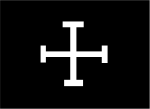
Puerto Rican Nationalist Party (Spanish: Partido Nacionalista Puertorriqueño) founded 1922 Popular Democratic Party of Puerto Rico (Spanish: Partido Popular Democrático de Puerto Rico) founded 1937 

Puerto Rican Independence Party (Spanish: Partido Independentista Puertorriqueño) founded 1946 New Progressive Party of Puerto Rico (Spanish: Partido Nuevo Progresista de Puerto Rico) founded 1967 Sports flags of Puerto Rico
The standard representative symbol carried by Puerto Ricans at international sports events, such as the Olympics, Pan American Games, Central American and Caribbean Games, and the World Cup of Baseball, is the Flag of Puerto Rico. However, various sports associations have adopted flags which are also used during sports events. Prior to the adoption of the Puerto Rican flag, athletes from the archipelago competed under both the United States flag and a special white banner containing a variation of the seal and the words "Puerto Rico" present above it.[38] The symbolism in this ensign includes a green background that represents the main island's vegetation, the Lamb of God symbolizing Jesus of Nazareth, and a book with the seven seals where the lamb sits, in reference to the Book of Revelation.
See also
- Coat of arms of Puerto Rico
- Seal of Puerto Rico
References
- ^ a b c The First Puerto Rican Flag
- ^ "Puerto Rico - Cinco Siglos de Historia"; by: Francisco Sacrano; publisher: McGraw Hill Interamericana, SA, 1993; pag. 533
- ^ a b Enciclopedia de Puerto Rico
- ^ Flags of the World; Commonwealth of Puerto Rico, Estado Libre Asociado de Puerto Rico, Flags of the World, Retrieved Feb. 25, 2009
- ^ a b Reglamento sobre el Uso en Puerto Rico de la Bandera del Estado Libre Asociado de Puerto Rico(Spanish), Commonwealth of Puerto Rico, Retrieved on Feb. 25, 2009 (Spanish)
- ^ a b "Boricua a Punto de Abordar El Discovery, Acaba llevara bandera de PR" - El Nuevo Dia; By Marcia Dunn Associated Press, Retrieved March 12, 2009 (Spanish)
- ^ Enchanted Learning, Zoom Explorers, Retrieved Feb. 25, 2009
- ^ Christopher Columbus' Flags 1492, Flags of the World, Retrieved Feb. 25, 2009
- ^ Spanish Burgundy Flag, University of Georgia, Retrieved Feb. 25, 2009
- ^ Lares
- ^ Peres Moris, José, Historia de la Insurrección de Lares, 1871 (Spanish), Library of Congress, Retrieved Feb. 25, 2009
- ^ Popular Expression and National Identity in Puerto Rico: The Struggle for Self, Community, and Nation; by Lillian Guerra; Pg. 200; Publisher: University Press of Florida; 1st edition (June 30, 1998); ISBN 0813015944; ISBN 978-0813015941
- ^ "Latin America's Wars Volume I: The Age of the Caudillo, 1791-1899"; by Robert L. Scheina; Pg. 359; Publisher: Potomac Books Inc.; 1 edition (January 2003); ISBN 1574884492; ISBN 978-1574884494
- ^ a b Vida, pasión y muerte de Francisco Gonzalo Marín
- ^ Antonio Vélez Alvarado, amigo y colaborador consecuente de Martí y Betances, Author: Dávila, Ovidio; pp. 11-13.; Publisher: San Juan, P.R. : Instituto de Cultura Puertorriqueña (Institute of Puerto Rican Culture), 2002. (Spanish)
- ^ Puerto Rico, Welcome to Puerto Rico, Retrieved Feb. 25, 2009
- ^ Lola Rodríguez de Tió, Library of Congress, Retrieved Feb. 25, 2009
- ^ "Historia militar de Puerto Rico"; by Hector Andres Negroni (Author); Pages: 307; Publisher: Sociedad Estatal Quinto Centenario (1992); Language: Spanish; ISBN 8478441387; ISBN 978-8478441389
- ^ Sabia Usted? (Spanish), Sabana Grande, Retrieved Feb. 25, 2009
- ^ The Flag, Flags of the World, Retrieved Feb. 25, 2009
- ^ Photos of the Jayuya Uprising, Latin American Studies, Retrieved Feb. 25, 2009
- ^ Puerto Rican History
- ^ a b "Puerto Rico: Culture, Politics, and Identity"; by Nancy Morris, Published by Praeger/Greenwood 1995; ISBN 0275954528. P.51
- ^ Flag of Puerto Rico by Martín Espada an authority and professor at the University of Massachusetts Amherst, Martín Espada, University of Massachusetts Amherst, Retrieved Feb. 25, 2009
- ^ "Luis Muñoz Marín: Puerto Rico's Democratic Revolution" Published by Editorial UPR, 2006; ISBN 0847701581. P.90
- ^ Flag of Puerto Rico, Flags of the World, Retrieved Feb. 25, 2009
- ^ Welcome to Puerto Rico - Flag of Puerto Rico, Welcome to Puerto Rico, Retrieved Feb. 25, 2009
- ^ Associated Press (2004-02-29). "No one expected attack on Congress in 1954". Holland Sentinel. Archived from the original on 2005-03-22. http://web.archive.org/web/20050322053617/http://www.hollandsentinel.com/stories/022904/fea_022904040.shtml. Retrieved 2008-09-19.
- ^ Vieques: A Photographically Illustrated Guide to the Island, Its History and Its Culture; by Gerald Singer; page 183; Publisher: Sombrero Publishing Company; ISBN 0964122049; ISBN 978-0964122048
- ^ http://www.elnuevodia.com/visitaralaislajosephacaba-574513.html
- ^ El Nuevo Dia, (Spanish Newspaer) Retrieved March 21, 2009
- ^ Banderade Lares
- ^ Barrios" Flags - Overview, Flags of the World, Retrieved Feb. 25, 2009
- ^ Flag of Utuado (Spanish), City of Utuado, Feb. 26, 2009
- ^ San German, Flags of the World, Retrieved Feb. 27, 2009
- ^ Political Flags of Puerto Rico, Flags of the World, Retrieved Feb. 25, 2009
- ^ Political Flags of Puerto Rico, "DC's Political Report", D.C. Finegold-Sachs, Retrieved Feb. 25, 2009
- ^ Flag at the Olympic Games in London 1948, Flags of the World, Retrieved Feb. 25, 2009
Primary sources
- Act No.1, Approved July 24, 1952.
- Regulations on the Use of the Puerto Rico flag. Núm. 5282, August 3, 1995 (Spanish)
- Mapas, Escudos y Banderas de Puerto Rico (Actualized ed.). Puerto Rico: Láminas Latino. 2007. (Spanish)
External links
- Puerto Rico at Flags of the World
- Puerto Rico flags at Vexilla mundi
- The Flag of The Jatibonicu Taíno Tribal Nation
Lists of flags Master list · Reference listState-related Arab states · Civil flag · Country · Date of Adoption · Formerly independent · Gay pride and Lesbian Bisexual Transgender flags · Heads of state · Historical flags · State flag · State flags and ensigns · Sovereign · Special and fictional · Unrecognized ·
Mobile militaryMobile civilianOther entities By design By nations Argentina · Armenia · Australia · Austria · Azerbaijan · Bahamas · Barbados · Belarus · Belgium · Bosnia and Herzegovina · Brazil · Cambodia · Canada · Chile · China · Colombia · Costa Rica · Croatia · Denmark · Dominican Republic · Egypt · Estonia · Finland · France · Germany · Georgia · Greece · Iceland · India · Ireland · Israel · Iraq · Italy · Jamaica · Japan · Kenya · Korea (South Korea) · Kosovo · Latvia · Lithuania · Luxembourg · Macedonia · Malaysia · Mexico · Malta · Moldova · Morocco · Montenegro · Netherlands · New Zealand · Norway · Pakistan · Peru · Poland · List of Polish naval and maritime flags · (voivodeships) · Portugal · Puerto Rico · Rhodesia · Romania · Russia (Russian Navy) · Serbia · Singapore · South Africa · Soviet Union (Soviet Navy) · Spain · Sri Lanka · Sweden · Switzerland · Thailand · Turkey · Ukraine · United Kingdom (England · Northern Ireland · Scotland · Wales · Falkland Islands · Gibraltar) · United States (CSA) · Uzbekistan · Vatican City · Yugoslavia · Zimbabwe
By continent Africa · Antarctica · Asia · Europe · North America · Oceania · South America
Names in italics indicate non-sovereign (dependent) territories and/or former countries.Flags of the US states, federal district, and insular areas States - Alabama
- Alaska
- Arizona
- Arkansas
- California
- Colorado
- Connecticut
- Delaware
- Florida
- Georgia
- Hawaii
- Idaho
- Illinois
- Indiana
- Iowa
- Kansas
- Kentucky
- Louisiana
- Maine
- Maryland
- Massachusetts
- Michigan
- Minnesota
- Mississippi
- Missouri
- Montana
- Nebraska
- Nevada
- New Hampshire
- New Jersey
- New Mexico
- New York
- North Carolina
- North Dakota
- Ohio
- Oklahoma
- Oregon
- Pennsylvania
- Rhode Island
- South Carolina
- South Dakota
- Tennessee
- Texas
- Utah
- Vermont
- Virginia
- Washington
- West Virginia
- Wisconsin
- Wyoming
Federal district Insular areas Flags of North America Sovereign states Dependencies and
other territoriesCategories:- Flags of the insular areas of the United States
- Puerto Rico national symbols
- History of Puerto Rico
Wikimedia Foundation. 2010.

